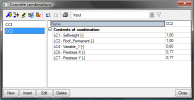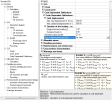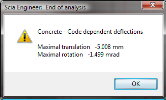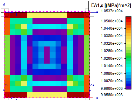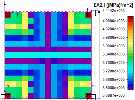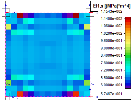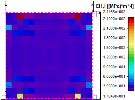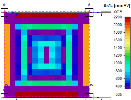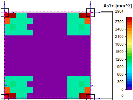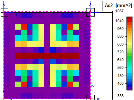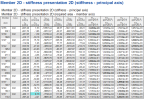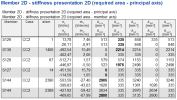10 Check deflection – code dependent calculation (CDD)
With respect to different modelling of the post-tensioned slab (see "4.1 Three possibilities of prestressing input") the evaluation of CDD deflections is available only for one of them. Code dependent calculation with the real post-tensioned tendons modelled by hanging nodes or allocated in the ribs is not possible in version SCIA Engineer 2011. The code dependent deflections are available only for the prestressing defined by the equivalent load. The background of the CDD calculation is more explained in "2D Concrete design - EC2; SCIA CZ, s.r.o, Prague 2011".
10.1 Concrete combinations
Concrete combinations are special combinations which are used only for the calculation of code dependent deflections (CDD). We have to prepare combinations with the same prescription as EN SLS quasi permanent. There is no special tool for preparation of the code dependent concrete combination in the program. All combinations have to be prepared manually.
Fig. 69 Concrete combination
We need to calculate the total and additional deflections for this slab according to 7.4.1 (4)(5) from "EN 1992-1-1 Eurocode 2, Design of Concrete Structures – Part 1: General rules and rules for buildings, European Committee for Standardization, December 2004.". That is why we have to prepare two concrete combinations. The first combination (CC1) will be used for calculation of the Total deflection and also deflection caused by the creep and long-term loads will be calculated from this combination. The second combination (CC2) will be used for the evaluation of the immediate deflection which will be used for calculation of the additional deflection
The prescriptions for the preparation of both combinations are based on EN SLS quasi-permanent combination with respect to the long term losses and are the following:


|
SW |
self weight |
|
DL |
dead load |
|
P |
prestressing |
|
LL |
life load |
Factors for prestressing mean short-term (0.9) and long-term losses (0.85)
Life load is from category F -> Ψ2 =0.6
Only one variable load can be inserted into a concrete combination for the calculation of the nonlinear deflection with creep because these combinations are not envelopes. We should prepare new combination for each variable loadcase.
The combinations look as the following in the program
Fig. 70 Concrete combinations
10.2 Code dependent calculation (Code Dependent Deflections = CDD)
The nonprestressed reinforcement (user defined or designed) is needed for the calculation of CDD. There are several options in Concrete solver > SLS > Code dependent deflection (CDD) defining how to deal with the reinforcement. The area of the user defined reinforcement (bars representing prestressing and 2D mesh reinforcement) will be taken into account for the calculation of the CDD as we set in concrete solver (see the following figure) – As,user. The designed and the user defined reinforcement in this calculation was used the same, as was done for the model with the real tendon and column heads (see chapter "7.3.3 Summary from Design ULS+SLS of longitudinal reinforcement").
Fig. 71 Settings in Concrete solver
Then everything is prepared for the CDD calculation. The first step is to run a linear calculation. When the linear calculation is finished then the CDD calculation can be run.
Fig. 72 Dialogue for running CDD
Afterwards we get the confirmation dialogue about general deflections.
Fig. 73 Confirmation dialogue after CDD calculation
10.3 Stiffness presentation
The service for stiffness presentation appears only after CDD calculation. This service is in Concrete Advanced tree (2D Member > Member check > Stiffness presentation).
Fig. 74 Service for stiffness presentation
It is possible to evaluate two types of values in this service:
- Required areas – areas of the reinforcement which are used for the CDD calculation (user or required areas)
- Stiffnesses – short-term (s) and long-term (l) axial (EA) and bending (EI) stiffnesses in both directions (1, 2)
The stiffnesses are the following. Graphical presentation is done for better overview again for the slab S138.
|
Shorterm |
Longterm |
|
|---|---|---|
|
EA1 |
||
|
EA2 |
||
|
EI1 |
||
|
EI2 |
The required areas are the following. Graphical presentation is done for better overview again for the slab S138. The values correspond with the user defined reinforcement (free bars representing prestressing and designed user defined 2D reinforcement).
|
Lower |
Upper |
|
|---|---|---|
|
A1 |
||
|
A2 |
10.4 Deformation check
After a successful run of the CDD a function for the evaluation of deflections appears in the concrete tree (2D Member > Member check > Deformations).
Fig. 75 Service for deformation check
Two checks of deflections are required according to 7.4.1(4)(5) from "EN 1992-1-1 Eurocode 2, Design of Concrete Structures – Part 1: General rules and rules for buildings, European Committee for Standardization, December 2004.". The deflections are evaluated in the following way. Two required checks are:
- Check of total deflection (7.4.1(4)) – the limit value L/250;


- Check of additional deflection (7.4.1(5)) – the limit value L/500

The total and additional deflections are not evaluated directly for 2D members. A special algorithm has to be applied to calculate these deflections.
10.4.1 Total deflection
Total deflection  is calculated for the combination including also variable loads (CC2) as the sum of the Elastic deformation
is calculated for the combination including also variable loads (CC2) as the sum of the Elastic deformation  and Creep deformation
and Creep deformation . Elastic deformation is nonlinear deformation for combination CC2. Creep deformation can be evaluated as the difference between Nonlinear+creep
. Elastic deformation is nonlinear deformation for combination CC2. Creep deformation can be evaluated as the difference between Nonlinear+creep and Nonlinear
and Nonlinear  for combination CC1 or CC2.
for combination CC1 or CC2.
In fact, Total deflection is the deflection for combination CC2 as type Nonlinear+creep 
CC2 
Fig. 76 Total deflection
The maximum value is  -> Check is satisfied.
-> Check is satisfied.
If the creep deformation  is also required then this value is calculated as difference between Nonlinear+creep
is also required then this value is calculated as difference between Nonlinear+creep and Nonlinear
and Nonlinear 
 deformation for combinations CC1 where check box calculated to creep has been switched ON:
deformation for combinations CC1 where check box calculated to creep has been switched ON:
CC1 

|

|
|
|---|---|---|
|
Screen |
||
|
Values |
--3,17mm |
-1,40mm |
|
|
-3,17 - (-1,40) = -1,77 mm |
|
10.4.2 Additional deflection
Additional deflection is calculated for combination CC2 as the difference between the total and immediate deflection. The immediate deflection is evaluated for combination CC1 as the nonlinear deflection .
.
CC1
CC2

|

|
|
|---|---|---|
|
Screen |
||
|
Values |
-6,15mm |
-1,40mm |
|
|
-6,15 - (-1,40) = -4,75 mm |
|
The maximum value is  -> Check is satisfied.
-> Check is satisfied.



